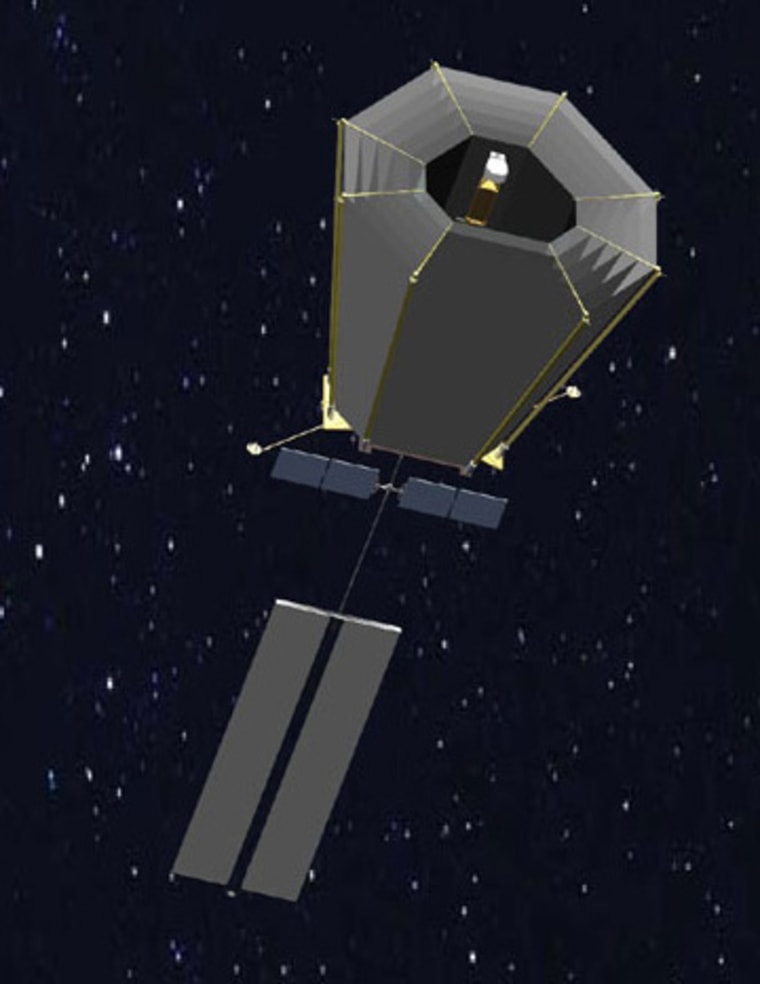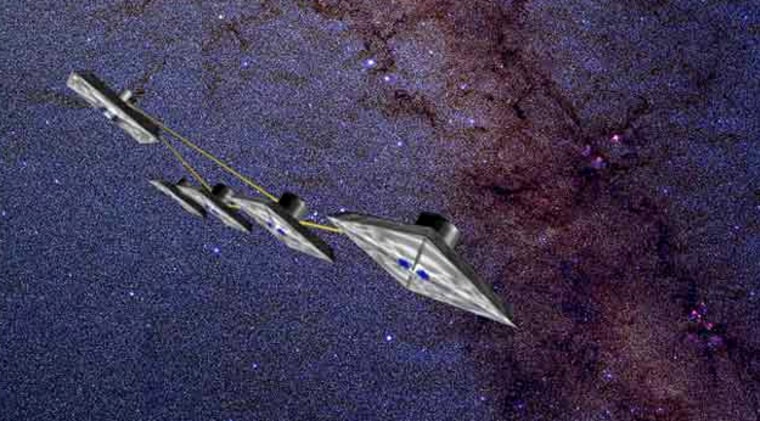After years of whittling away prospective designs for a NASA mission to search for Earthlike planets around alien stars, the space agency had narrowed the choice down to two very different observatories.
The first — a coronagraph — would blot out a star's light in the hopes of seeing small orbiting planets, while the other — an interferometer — would use a fleet of infrared telescopes working in tandem to hunt for the same extrasolar quarry.
But instead of choosing one instrument over the other, NASA has adopted both, giving researchers with the agency's Terrestrial Planet Finder project, or TPF, twice the capability of making direct observations of an Earthlike extrasolar planet.
"We'd always known that it was a good thing to do both [versions]," Charles Beichman, TPF project scientist at NASA's Jet Propulsion Laboratory, said in a telephone interview. "And we thought, well, we'll have to make an agonizing choice sooner or later."
Pursuing both space telescope configurations, a duet that project planners pared down from about 60 potential approaches, also fits in with President Bush's space vision. Bush included the development of advanced telescopes for extrasolar planet hunts in his Jan. 14 speech, during which he also called for the retirement of the space shuttle and an effort to send humans back to the moon and on to Mars.
"Everybody is focusing on Mars and the lunar studies, and that's great," said Dan Coulter, TPF project manager. "But this is part of the space vision, too."
A complementary combination
While the architectures of the coronagraph (TPF-C) and interferometer (TPF-I) versions of TPF are different, they can be used to complement each other and give researchers a more comprehensive look at extrasolar planets than any seen before.
"It's not that twice as much data is twice as good," Beichman said. "It's actually that twice as much data is 10 times as good."
It would be difficult, using only a visible light-based instrument, to determine whether an object in the sky like the newly discovered Sedna, for example, was something small and bright, or merely something large and dim of the same magnitude, researchers said. The addition of the infrared instrument provides a check in the observational system.

Initial designs for the space coronagraph, expected to be the first of the planet-hunting pair to launch, calls for a moderate-sized visible-light telescope similar to a 13-by-20-foot (4-by-6-meter) mirror currently under study. The coronagraph would use a central disc, as well as other techniques, to blot out a star's glare. That would allow the instrument to detect planets that would otherwise be hard to spot. A tentative launch date for the coronagraph is expected sometime in 2014.
Like all interferometers, the second TPF instrument, to launch by the end of 2020, will combine the light from multiple telescopes to make detailed observations of stars and planets. But the TPF interferometer will be fundamentally different from Earth-based interferometers — and even the planned Space Interferometry Mission set for launch in 2009-2010. Those other instruments are connected by a hard and fast baseline, while the TPF version is designed to be a free-flying fleet of 13-foot (4-meter) telescopes that constantly shift themselves to keep the proper orientation.
The ability to design and build a set of telescopes capable of flying in formation while maintaining the precision and stability necessary for proper observations is a challenge, and researchers are working with their counterparts at the European Space Agency to meet the task. ESA is developing its own formation-flying interferometer mission, dubbed Darwin, to fly in 2014.
"What you get from having both missions is a much more complete understanding of the planets and a more robust search for the detection of life," Coulter told Space.com. "In the past, the primary goal was just detecting other planets, but it’s also the characterization of habitability we're interested in."
Finding an Earth-sized world, he added, is not enough. The TPF effort seeks to determine the specific characteristics of any atmosphere present around a planet and develop an understanding of whether the world does or could ever have harbored life.
Avoiding supersized planets
TPF mission planners don't plan on looking where other planet hunters been successful in the past.
Most of today's known extrasolar worlds are planetary behemoths, the size of Jupiter or larger, circling close to their parent stars. Because of their size and proximity to the star, such planets can be detected by the "wobble" their gravity causes on their stellar parents. But those systems appear unlikely to harbor an Earth-sized planet in a habitable orbit where liquid water could exist, researchers said.
"A lot of the systems that we've been finding to date with that technique are not very favorable because they have big fat planets sitting right in the habitable zone," Beichman said. "If you have Jupiter driving around, and you're lying on the freeway, you're likely to get squished."
The TPF coronagraph is expected to be a planetary pathfinder, conducting complete surveys of up to 50 stars, and partially studying another 50. But because the telescope's size is limited by launch constraints, the coronagraph does have a limit to its stellar resolution, researchers said.
That, however, is where the infrared TPF interferometer will pick up the planet-hunting baton, checking the coronagraph findings and taking a close look at up to 200 stars with 500 others set aside for partial study.
"It would be good to get the sensitivity down to half of Earth's size," Richard Key, TPF project engineer, said of the two telescopes.
Steppingstones to better space telescopes
Although TPF architectures are in hand, there still remains the hurdle of building both instruments and lofting them into space.
The coronagraph appears to be the easier of the two telescopes in terms of design, hence its earlier launch date. But intricacies of a formation-flying interferometer are not simple challenges to surmount.
European Space Agency researchers are planning to conduct formation-flying tests with their SMART-3 technology mission in upcoming years, the results of which could prove very valuable to both the European Darwin effort and TPF as well. Beichman said. Even the more advanced TPF and Darwin missions will help other researchers to plan the eventual Life Finder and Planet Imager telescopes that sit perhaps 50 years in the future, he added.
"We're at the same stage that early astronomers were at the beginning of the 20th century, when the idea of a Hubble Telescope or James Webb Space Telescope was almost beyond [conception]," Beichman said. "We're making the same first halting steps."
